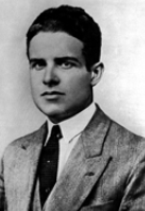U.Porto Memory
University of Porto Famous Alumni
Rui de Serpa Pinto
 |
Rui de Serpa Pinto 1907-1933 Engineer, archeologist, anthropologist and bibliographer |
Rui Correia de Serpa Pinto was born in Porto, in the parish of Santo Ildefonso, on 6 August 1907. He was the son of Hernâni de Serpa Pinto and Aurora Basto Correia de Serpa Pinto.
After concluding High School with excellent grades, he graduated in Mathematics (1924) in the Faculty of Sciences, and in Civil Engineering in the Faculty of Engineering of the University of Porto.
In 1925, while he was still a student, he made his first scientific breakthrough when he identified the lythic industries of the Asturian kind in the region of Vila Praia de Âncora. This discovery was published three years later with the title "O Asturiense em Portugal." ["The Asturian in Portugal"]. Still in this phase of his life, he attended the Marian Congregation of Santo Ildefonso, where he was an assistant.
Rui de Serpa Pinto was a teacher both in Secondary and Higher Education. In 1930, after a competitive examination, he was nominated assistant of the Sciences Group, where he was already collaborating with the Anthropology Institute. In 1931 he was involved in the foundation of the Brotero College, in whose direction he participated.
Within the Civil Engineering field, he was one of the founders of the "Associated Engineering Society" in Porto.
 Rui de Serpa Pinto developed an interest in several areas: Pre and Proto-History, Medieval Archaeology, Numismatics, Paleontology, Geology, Epigraphy and Bibliography. He visited museums, archives, libraries and archeological sites throughout the country, as well as museums and archeological stations in Spain, France, Italy and England.
Rui de Serpa Pinto developed an interest in several areas: Pre and Proto-History, Medieval Archaeology, Numismatics, Paleontology, Geology, Epigraphy and Bibliography. He visited museums, archives, libraries and archeological sites throughout the country, as well as museums and archeological stations in Spain, France, Italy and England.
He corresponded with culture-realted personalities and submitted communications in scientific gatherings. He collaborated in sessions of the Portuguese Society of Anthropology and Ethnology and he was a member of several scientific institutions, national and international, namely the Portuguese Archeologists’ Association, the Portuguese Society of Meteorology and Geophysics, the Galician Studies seminar, the International Anthropology Institute, the French Pre-Historic Society, the London Society of Antiquarians.
A practising Catholic, as a student he attended the Marian Congregation of Santo Ildefonso and was the vice-president of the Catholic Youth, within which he created the academic nucleus of S. João Crisóstomo.
"Le Jeune", as he was known among Archaeology scholars, died in Porto on 23 March 1933 when he was only 25 years old, victim of typhoid septicemia. Despite his short life, he left an important work for all of those who take an interest in the study of the Northwest Archaeology.
His grave in Agramonte cemetery bears the following epitaph: "Youth, talent, virtues. He was fair and wise. He shared his short but bright life with the love for God, Family and Science. You show at 25 a full flight of glory. He will live on forever in the heart of those who loved him.".
(Universidade Digital / Gestão de Informação, 2012)
Last updated: 2016-07-06 Webpage created on: 2025-06-24 15:26:58 Complaint Portal